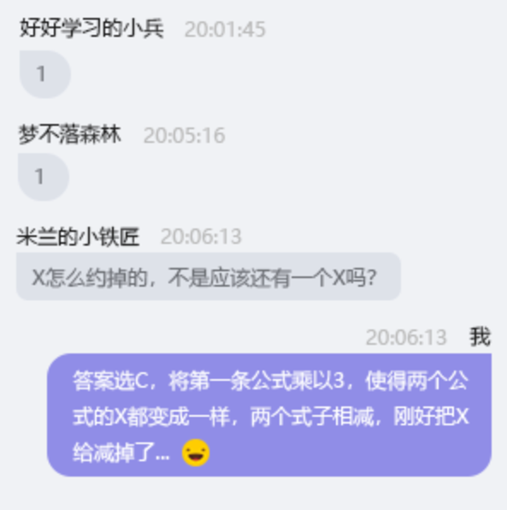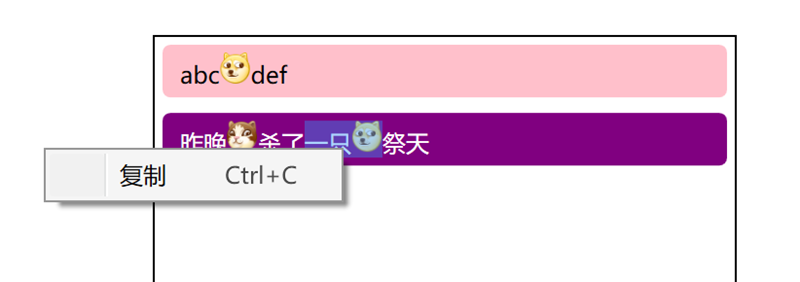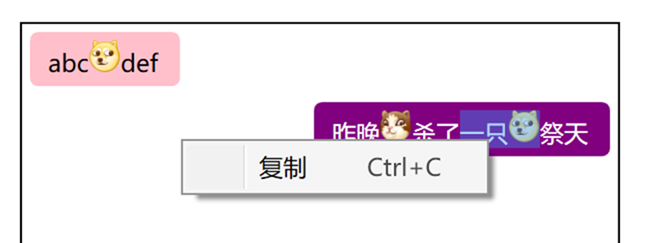最近公司有个项目,是要求实现类似 QQ 聊天这种功能的。
如下图
这没啥难的,稍微复杂的也就表情的解析而已。
表情在传输过程中的实现参考了新浪微博,采用半角中括号代表表情的方式。例如:“abc[doge]def”就会显示 abc,然后一个![]() ,再 def。
,再 def。
于是动手就干。
创建一个模板控件来进行封装,我就叫它 ChatMessageControl,有一个属性 Text,表示消息内容。内部使用一个 TextBlock 来实现。
于是博主三下五除二就写出了以下代码:
C#
[TemplatePart(Name = TextBlockTemplateName, Type = typeof(TextBlock))] public class ChatMessageControl : Control { public static readonly DependencyProperty TextProperty = DependencyProperty.Register(nameof(Text), typeof(string), typeof(ChatMessageControl), new PropertyMetadata(default(string), OnTextChanged)); private const string TextBlockTemplateName = "PART_TextBlock"; private static readonly Dictionary<string, string> Emotions = new Dictionary<string, string> { ["doge"] = "pack://application:,,,/WpfQQChat;component/Images/doge.png", ["喵喵"] = "pack://application:,,,/WpfQQChat;component/Images/喵喵.png" }; private TextBlock _textBlock; static ChatMessageControl() { DefaultStyleKeyProperty.OverrideMetadata(typeof(ChatMessageControl), new FrameworkPropertyMetadata(typeof(ChatMessageControl))); } public string Text { get => (string)GetValue(TextProperty); set => SetValue(TextProperty, value); } public override void OnApplyTemplate() { _textBlock = (TextBlock)GetTemplateChild(TextBlockTemplateName); UpdateVisual(); } private static void OnTextChanged(DependencyObject d, DependencyPropertyChangedEventArgs e) { var obj = (ChatMessageControl)d; obj.UpdateVisual(); } private void UpdateVisual() { if (_textBlock == null) { return; } _textBlock.Inlines.Clear(); var buffer = new StringBuilder(); foreach (var c in Text) { switch (c) { case '[': _textBlock.Inlines.Add(buffer.ToString()); buffer.Clear(); buffer.Append(c); break; case ']': var current = buffer.ToString(); if (current.StartsWith("[")) { var emotionName = current.Substring(1); if (Emotions.ContainsKey(emotionName)) { var image = new Image { Width = 16, Height = 16, Source = new BitmapImage(new Uri(Emotions[emotionName])) }; _textBlock.Inlines.Add(new InlineUIContainer(image)); buffer.Clear(); continue; } } buffer.Append(c); _textBlock.Inlines.Add(buffer.ToString()); buffer.Clear(); break; default: buffer.Append(c); break; } } _textBlock.Inlines.Add(buffer.ToString()); } }
因为这篇博文只是个演示,这里博主就只放两个表情好了,并且耦合在这个控件里。
XAML
<Style TargetType="local:ChatMessageControl"> <Setter Property="Template"> <Setter.Value> <ControlTemplate TargetType="local:ChatMessageControl"> <TextBlock x:Name="PART_TextBlock" TextWrapping="Wrap" /> </ControlTemplate> </Setter.Value> </Setter> </Style>
没啥好说的,就是包了一层而已。
效果:
自我感觉良好,于是乎博主就提交代码,发了个版本到测试环境了。
但是,第二天,测试却给博主提了个 bug。消息无法选择、复制。
在 UWP 里,TextBlock 控件是有 IsTextSelectionEnabled 属性的,然而 WPF 并没有。这下头大了,于是博主去查了一下 StackOverflow,大佬们回答都是说用一个 IsReadOnly 为 True 的 TextBox 来实现。因为我这里包含了表情,所以用 RichTextBox 来实现吧。不管行不行,先试试再说。
在原来的代码上修改一下,反正表情解析一样的,但这里博主为了方便写 blog,就新开一个控件好了。
C#
[TemplatePart(Name = RichTextBoxTemplateName, Type = typeof(RichTextBox))] public class ChatMessageControlV2 : Control { public static readonly DependencyProperty TextProperty = DependencyProperty.Register(nameof(Text), typeof(string), typeof(ChatMessageControlV2), new PropertyMetadata(default(string), OnTextChanged)); private const string RichTextBoxTemplateName = "PART_RichTextBox"; private static readonly Dictionary<string, string> Emotions = new Dictionary<string, string> { ["doge"] = "pack://application:,,,/WpfQQChat;component/Images/doge.png", ["喵喵"] = "pack://application:,,,/WpfQQChat;component/Images/喵喵.png" }; private RichTextBox _richTextBox; static ChatMessageControlV2() { DefaultStyleKeyProperty.OverrideMetadata(typeof(ChatMessageControlV2), new FrameworkPropertyMetadata(typeof(ChatMessageControlV2))); } public string Text { get => (string)GetValue(TextProperty); set => SetValue(TextProperty, value); } public override void OnApplyTemplate() { _richTextBox = (RichTextBox)GetTemplateChild(RichTextBoxTemplateName); UpdateVisual(); } private static void OnTextChanged(DependencyObject d, DependencyPropertyChangedEventArgs e) { var obj = (ChatMessageControlV2)d; obj.UpdateVisual(); } private void UpdateVisual() { if (_richTextBox == null) { return; } _richTextBox.Document.Blocks.Clear(); var paragraph = new Paragraph(); var buffer = new StringBuilder(); foreach (var c in Text) { switch (c) { case '[': paragraph.Inlines.Add(buffer.ToString()); buffer.Clear(); buffer.Append(c); break; case ']': var current = buffer.ToString(); if (current.StartsWith("[")) { var emotionName = current.Substring(1); if (Emotions.ContainsKey(emotionName)) { var image = new Image { Width = 16, Height = 16, Source = new BitmapImage(new Uri(Emotions[emotionName])) }; paragraph.Inlines.Add(new InlineUIContainer(image)); buffer.Clear(); continue; } } buffer.Append(c); paragraph.Inlines.Add(buffer.ToString()); buffer.Clear(); break; default: buffer.Append(c); break; } } paragraph.Inlines.Add(buffer.ToString()); _richTextBox.Document.Blocks.Add(paragraph); } }
XAML
<Style TargetType="local:ChatMessageControlV2"> <Setter Property="Foreground" Value="Black" /> <Setter Property="Template"> <Setter.Value> <ControlTemplate TargetType="local:ChatMessageControlV2"> <RichTextBox x:Name="PART_RichTextBox" MinHeight="0" Background="Transparent" BorderBrush="Transparent" BorderThickness="0" Foreground="{TemplateBinding Foreground}" IsReadOnly="True"> <RichTextBox.Resources> <ResourceDictionary> <Style TargetType="Paragraph"> <Setter Property="Margin" Value="0" /> <Setter Property="Padding" Value="0" /> <Setter Property="TextIndent" Value="0" /> </Style> </ResourceDictionary> </RichTextBox.Resources> <RichTextBox.ContextMenu> <ContextMenu> <MenuItem Command="ApplicationCommands.Copy" Header="复制" /> </ContextMenu> </RichTextBox.ContextMenu> </RichTextBox> </ControlTemplate> </Setter.Value> </Setter> </Style>
XAML 稍微复杂一点,因为我们需要让一个文本框高仿成一个文字显示控件。
感觉应该还行,然后跑起来之后
复制是能复制了,然而我的布局呢?
因为一时间也没想到解决办法,于是博主只能回滚代码,把 bug 先晾在那里了。
经过了几天上班带薪拉屎之后,有一天博主在厕所间玩着宝石连连消的时候突然灵光一闪。对于 TextBlock 来说,只是不能选择而已,布局是没问题的。对于 RichTextBox 来说,布局不正确是由于 WPF 在测量与布局的过程中给它分配了无限大的宽度。那么,能不能将两者结合起来,TextBlock 做布局,RichTextBox 做功能呢?想到这里,博主关掉了宝石连连消,擦上屁股,开始干活。
C#
[TemplatePart(Name = TextBlockTemplateName, Type = typeof(TextBlock))] [TemplatePart(Name = RichTextBoxTemplateName, Type = typeof(RichTextBox))] public class ChatMessageControlV3 : Control { public static readonly DependencyProperty TextProperty = DependencyProperty.Register(nameof(Text), typeof(string), typeof(ChatMessageControlV3), new PropertyMetadata(default(string), OnTextChanged)); private const string RichTextBoxTemplateName = "PART_RichTextBox"; private const string TextBlockTemplateName = "PART_TextBlock"; private static readonly Dictionary<string, string> Emotions = new Dictionary<string, string> { ["doge"] = "pack://application:,,,/WpfQQChat;component/Images/doge.png", ["喵喵"] = "pack://application:,,,/WpfQQChat;component/Images/喵喵.png" }; private RichTextBox _richTextBox; private TextBlock _textBlock; static ChatMessageControlV3() { DefaultStyleKeyProperty.OverrideMetadata(typeof(ChatMessageControlV3), new FrameworkPropertyMetadata(typeof(ChatMessageControlV3))); } public string Text { get => (string)GetValue(TextProperty); set => SetValue(TextProperty, value); } public override void OnApplyTemplate() { _textBlock = (TextBlock)GetTemplateChild(TextBlockTemplateName); _richTextBox = (RichTextBox)GetTemplateChild(RichTextBoxTemplateName); UpdateVisual(); } private static void OnTextChanged(DependencyObject d, DependencyPropertyChangedEventArgs e) { var obj = (ChatMessageControlV3)d; obj.UpdateVisual(); } private void UpdateVisual() { if (_textBlock == null || _richTextBox == null) { return; } _textBlock.Inlines.Clear(); _richTextBox.Document.Blocks.Clear(); var paragraph = new Paragraph(); var buffer = new StringBuilder(); foreach (var c in Text) { switch (c) { case '[': _textBlock.Inlines.Add(buffer.ToString()); paragraph.Inlines.Add(buffer.ToString()); buffer.Clear(); buffer.Append(c); break; case ']': var current = buffer.ToString(); if (current.StartsWith("[")) { var emotionName = current.Substring(1); if (Emotions.ContainsKey(emotionName)) { { var image = new Image { Width = 16, Height = 16 };// 占位图像不需要加载 Source 了 _textBlock.Inlines.Add(new InlineUIContainer(image)); } { var image = new Image { Width = 16, Height = 16, Source = new BitmapImage(new Uri(Emotions[emotionName])) }; paragraph.Inlines.Add(new InlineUIContainer(image)); } buffer.Clear(); continue; } } buffer.Append(c); _textBlock.Inlines.Add(buffer.ToString()); paragraph.Inlines.Add(buffer.ToString()); buffer.Clear(); break; default: buffer.Append(c); break; } } _textBlock.Inlines.Add(buffer.ToString()); paragraph.Inlines.Add(buffer.ToString()); _richTextBox.Document.Blocks.Add(paragraph); } }
C# 代码相当于把两者结合起来而已。
XAML
<Style TargetType="local:ChatMessageControlV3"> <Setter Property="Foreground" Value="Black" /> <Setter Property="Template"> <Setter.Value> <ControlTemplate TargetType="local:ChatMessageControlV3"> <Grid> <TextBlock x:Name="PART_TextBlock" Padding="6,0,6,0" IsHitTestVisible="False" Opacity="0" TextWrapping="Wrap" /> <RichTextBox x:Name="PART_RichTextBox" Width="{Binding ElementName=PART_TextBlock, Path=ActualWidth}" MinHeight="0" Background="Transparent" BorderBrush="Transparent" BorderThickness="0" Foreground="{TemplateBinding Foreground}" IsReadOnly="True"> <RichTextBox.Resources> <ResourceDictionary> <Style TargetType="Paragraph"> <Setter Property="Margin" Value="0" /> <Setter Property="Padding" Value="0" /> <Setter Property="TextIndent" Value="0" /> </Style> </ResourceDictionary> </RichTextBox.Resources> <RichTextBox.ContextMenu> <ContextMenu> <MenuItem Command="ApplicationCommands.Copy" Header="复制" /> </ContextMenu> </RichTextBox.ContextMenu> </RichTextBox> </Grid> </ControlTemplate> </Setter.Value> </Setter> </Style>
XAML 大体也是将两者结合起来,但是把 TextBlock 设置为隐藏(但占用布局),而 RichTextBox 则绑定 TextBlock 的宽度。
至于为啥 TextBlock 有一个左右边距为 6 的 Padding 嘛。在运行之后,博主发现,RichTextBox 的内容会离左右有一定的距离,但是没找到相关的属性能够设置,如果正在看这篇博文的你,知道相关的属性的话,可以在评论区回复一下,博主我将会万分感激。
最后是我们的效果啦。
最后,因为现在 WPF 是开源(https://github.com/dotnet/wpf)的了,因此已经蛋疼不已的博主果断提了一个 issue(https://github.com/dotnet/wpf/issues/307),希望有遇到同样困难的小伙伴能在上面支持一下,让巨硬早日把 TextBlock 选择这功能加上。





